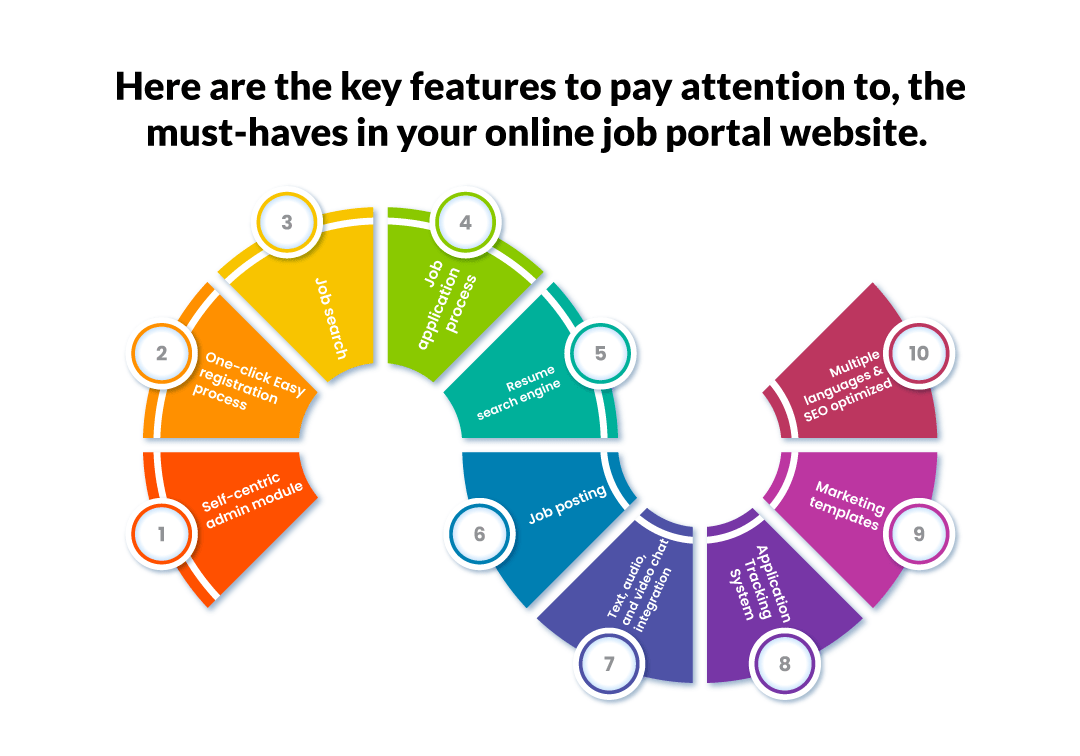94% of recruitment professionals mentioned that they need an online job portal website for their hiring needs. Right from allowing the candidates to view the requirement to having the candidate apply for the job and assessment and applicant tracking, an effective job portal website design allows for each step in the candidate’s hiring journey.
Before moving further, there are some things you should know about job portal websites.
Here are the key features to pay attention to, the must-haves in your online job portal website.
 1. Self-Centric admin module
1. Self-Centric admin module
Multiple users like HR leadership and HR managers should be able to review the entire HR operations from a single dashboard. They can view the number of jobs posted, the number of positions filled, overdue postings, notifications, and messages on their dashboard. They must have access to the following features in the admin module or portal.
Looking to improve your organization’s hiring process? We’ve helped companies like yours build functional online job portal websites for seamless recruitment.
The key admin features in the job portal website design are:
Resume parsing and document management
On the online job portal website, HR must be able to upload resumes and get an instant list of all candidates with their profile information, skills, experience, and matching % with a job listing available in the system.
The resume parsing ability should be driven by AI and ML so that it can learn with the steps taken by an HR to auto-adjust the matching criteria. With the standard sort and search feature available in the admin module, it should be easy to find the desired candidate list in a simple job portal website design.
Recruitment tools
Apart from the basic recruitment tools like posting jobs, receiving applicants, an online job portal website must support the concept of advanced tools like a single page to view postings and the number of applicants categorized into the possibility of shortlist/joining, analytics related to providing a score to a candidate based on their candidature, and an option to override the applicant results based on rules set up by HR or a manual shortlist.
The job board app must differentiate the manual vs automated score and should have an advanced search bar to filter the candidates by location, remote work, notice period, and other filters as decided by an HR partner. The entire process should be driven by a step-by-step wizard and should have tooltips and visual indicators to ensure that HR does not require IT help in managing or accessing the recruitment tools for their daily work.
Revenue model management
Before accessing this feature on the job board software, you must decide if you want to charge for a featured posting, number of postings, a candidate’s featured profile posting, resume writing, and consulting services and should prepare a rate card for the same with one-time, monthly, yearly subscriptions plans. Your plans should match the features present on your site and should be decided based on the current job board rate plan.
Once decided, you must have a template in the admin module to click on a type of revenue model and enter your product prices, click if you want to charge one-time or recurring, and then activate that revenue model module.
You should be able to get analytics and reports based on the revenue model and get a report of the most successful vs least successful revenue model for better decision making.
Moreover, you can also offer resume download limits and banner advertisements as part of your revenue monetization as these are extremely popular today. The features should be accessible through a minimal job portal website design to appeal to an HR recruiter of any age group.
Also Read: How Can You Develop Job Portal Software in 4 Steps
Looking to build a feature-rich online job board portal? Contact Artha Job Board Technologies to understand the key features you’ll require.
2. One-click or easy registration process
You should be able to log in with social media including Gmail, and LinkedIn and connect your profile instantly. You should have the option to log in via mobile and email through the OTP mechanism to ensure security.
The profile should build automatically based on uploaded documents and recruiters should spend minimal time straightening their profile in the online job portal website. The job hiring platform should have an option to add video, audio, or text media related to your company and job profile.
3. Job search
A job search within the job hiring platform should be driven by basic and advanced searches. The job portal website design should include a basic search filter with the option to search by role, title, zip, location, and then candidates can filter the postings by advanced filters like salary, geo-location, department, sub-department, remote work allowed, visa requirements, hot jobs, and other filters as decided by an HR executive.
For users seeking free job board software,Additional job board hiring platform features include the latest postings, the company’s ratings, and relevance. Guest users must also have the option to search first and then log in to create their profile and apply to jobs.
Candidates must have the option to save job searches and create an alert when a new job is posted. Employers can also create an alert when a candidate applies for a job. The online job portal website must provide an option to provide an RSS feed of the job to integrate into any portal via the iFrame.
4. Job application process
HR should have an option to use the job portal website design and create unique recruitment process templates. The template must include the job stages as per the requirement like applied, shortlisted, interview scheduled, assessment completed, rejected/hired, offer declined, joined, and onboarded. These stages should be driven by a timeline, rules, and also manual touch.
Candidates can apply for a job through their mobile app or save a job to apply for it later. They can view all the saved jobs as soon as they log in and ensure no job posting is missed. There should be an option within the online job portal website to apply to multiple jobs in a single click.
Candidates and employers should be able to subscribe to SMS, and email alerts to never miss a job update. You also need to have push notifications and a geo-location feature that can automatically notify a candidate that a job posting can be applied as per his or her location.
Jobs can be saved/bookmarked and edited at a further stage. The online job portal website must allow the option to resume job applications and the job submission process for the users to save time in typing the details again. With the inclusion of resume and job posting parsing, automatic saving, and bookmarking, the administrative efforts must be minimal so that HR and candidates can concentrate on the core prospect of job posting and job application submission.
Also Read: Top Job Board Website Templates for a Professional Online Presence
5. Resume search engine
Recruiters can search for a resume by keywords, skills, location, industry, certification, mandatory skills, matching score, and review searches. The job portal website design should be such that your HR department can save searches to receive new resumes directly in their application, SMS, or email without any hassles.
6. Job posting
Recruiters can add their keywords, meta tags, and application suggested keywords to the job hiring platform to drive better search results. The automatic tagging of keywords and meta tags along with user-defined keywords helps in scenarios where a search can happen on the job portal’s partner sites and can get you results in terms of quantity and quality.
Recruiters can select a job template and attach it to a job posting. Post that, the search engine will combine all the information like keywords, meta tags, and template requirements to automatically select candidates and also send the next steps to the candidates like performing assessments, filling a mandatory form and more.
7. Text, audio, and video chat integration
In a typical job portal website design, you must have the features to start a text, audio, or video chat without buffering. The job portal must provide the option to schedule text/video/audio interviews and send the invitation to the respective parties automatically. You can also choose to mask the contact details of the interviewers for safeguarding their privacy.
8. Application Tracking System (ATS) and Re-engagement
The ATS feature of the online job portal website must provide a complete analytical view of the number of applications and their statuses with an option to re-hire or re-engage a candidate by simply sending them messages if they are still open for a job. You can also manage the CRM system related to job prospecting and create your job CRM cycle.
9 – Content management systems and marketing templates
Your job portal must have the option to create pages as per the company branding and also have the option to create newsletters and schedule them from time to time to send updates to a large user base. With the branding elements, companies who use your job board software can create a personalized experience and motivates the user to stay in touch with you and your company for future job postings.
10 – Multiple languages and SEO optimized
If you are thinking of multi-lingual support as a part of your job portal website design, remember that you need to have a support team dedicated to translation and customer support. From the tech side, you can create language templates and run your version of the site at any location [you need to meet infrastructure requirements for the same].
Final thoughts
All the above key elements can be developed from scratch and you can easily customize the features. Many leading job board software has taken that route. Are you ready to create a custom online job portal website? Schedule your first free demo with Artha Job Board Technologies.
Talk to our experts to know more about how we can design your job portal website.

 1. Self-Centric admin module
1. Self-Centric admin module




